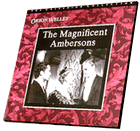

USA film school
1942
bw 88 min.
Director: Orson Welles
CAV: $99.95 - available
2 discs, catalog # CC1109L
CLV: $49.95 - available
1 disc, catalog # CC1324L
If
events had turned out differently,The Magnificent Ambersons, Orson Welles'
second film, might well be widely regarded as "the greatest film of all time"
rather than Citizen Kane. But in Welles' absence, RKO Studios recut the
original version of the film mercilessly -- Welles said it looked like it had
been "edited with a lawn mower" -- reducing its running time from 131 to the
present 88 minutes. Nevertheless, what survives is still one of the most
strikingly beautiful and technically innovative films ever to come out of
Hollywood. It also tells a good story -- about the decline of a once powerful and
wealthy turn-of-the-century Midwestern family -- with a conviction and maturity
that are rare for the old Hollywood system.
It was a well-kept secret that
Citizen Kane left Welles so emotionally and creatively exhausted that he
was sent away on doctor's orders to undergo a rest cure. The only surprise in
this is that he had managed to hold out for so long. Citizen Kane was the
culmination of almost a decade of frenetic energy that included early fame on
Broadway and in radio, a short-lived but widely felt revolution in the American
theater, the international scandal of the "War of the Worlds" broadcast, and a
Hollywood contract that virtually gave him carte blanche. In Kane, at age 25, he
had taken on one of the most powerful figures in American public life, publisher
William Randolph Hearst, and after the film was made, had had to resist crushing
pressures from all sides to get it released.
When he turned to his second film,
Welles was in a quieter, more reflective mood. Critics have puzzled over his
choice of The Magnificent Ambersons. Perhaps we should see it as an
episode of personal stock-taking after a prolonged interval of intense stress.
With its strongly autobiographical elements -- its setting at the time and place
of Welles' own youth, its brash and arrogant and supremely self-confident young
hero, and its obsessive Oedipal concerns -- clearly Tarkington's novel is serving
at one level as a means for Welles to delve into his own roots and search out the
meaning of his own personal past.
In an earlier, simpler time, how many
millions of American boys read Penrod, Booth Tarkington's modern version of
Huckleberry Finn? Welles did, and many other Tarkington works. Tarkington was a
regular staple for Welles' Mercury Theatre radio show, and on the Mercury Theatre
broadcast of the novel he called The Magnificent Ambersons, "the truest,
cruelest picture of the growth of the Middle West." At 240 pounds and well over
six feet, Welles was wrong for George, Tarkington's college-boy hero, in the
film. In a move that surprised everyone, he selected RKO contract player Tim Holt
for the role. (Usually thought of as just a cowboy actor, Holt turned in several
notable dramatic performances in his career, most especially in The
Magnificent Ambersons and in John Huston's The Treasure of the Sierra
Madre.) For the mother, Welles brought silent star Dolores Costello, one of
the great beauties of the 1920s and the former Mrs. John Barrymore, out of
retirement. For George's sweetheart, he selected an unknown starlet Anne Baxter
-- another inspired choice, as her subsequent career, especially in All About
Eve, amply shows. The roster was filled out with Mercury Theatre players who
had also been in Citizen Kane -- most notably Joseph Cotten, at his most
insinuatingly charming, and, unforgettably, Agnes Moorehead, who won the New York
Film Critics' Award for her performance. Although Welles did not appear onscreen
himself, he was present in the role he perhaps coveted most -- that of the
voice-over narrator, intoning Tarkington's elegant, old-fashioned prose. On the
technical side, Bernard Herrmann, another hold-over from Citizen Kane,
composed one of his subtlest scores; Stanley Cortez, a relative unknown, as
cinematographer was responsible for the astonishingly beautiful lighting of the
interior scenes; and veteran art director Mark-Lee Kirk was borrowed from 20th
Century Fox to oversee the design and constructionof the Ambersons' mansion, one
of the costliest and most complex sets ever built on a Hollywood sound
stage.
Midway through the shooting of The Magnificent Ambersons, Welles
was recruited by the U.S. State Department Committee on Inter-American Affairs to
make a film in South America as a gestureto promote hemispheric relations
inwartime. He rushed Ambersons to completion, entrusting the final editing
(according to his close in-tructions) to Robert Wise, another holdover from
Citizen Kane, and departed for South America. When the Welles version
elicited disastrous results in sneak previews, the RKO regime ordered Wise to
recut The Magnificent Ambersons into "releasable" shape. More than 50
minutes of Welles' footage were removed, and several scenes were rewritten and
reshot by others. This radically shortened version was put into release, and the
studio ordered all surviving footage from the original version destroyed. Welles
was terminated from RKO, and never again in his career was he entrusted with the
direction of a major studio feature.
Even in its truncated form, the brilliance
of The Magnificent Ambersons is evident. This was demonstrated most
strikingly in 1982, when leading international film critics voted it one of the
ten greatest films ever made.
-- ROBERT
CARRINGER
Credits
Production: A Mercury Theatre Production for RKO
Radio Pictures
Direction: Orson Welles
Screenplay: Orson Welles
Writing
Assistant: Amalia Kent
Source: The Magnificent Ambersons (1918), novel
by Booth Tarkington
Cinematography: Stanley Cortez, A.S.C.
Second Unit:
Harry Wild, A.S.C.
Art Direction: Mark-Lee Kirk
Storyboards and Sketches:
Joe St. Amon
Sound: Bailey Fesler, James G. Stewart
Costumes: Edward
Stevenson
Score (Uncredited): Bernard Herrmann
Additional Music: Roy
Webb
Editing: Robert Wise
Shot at the RKO-Pathe Studios, Culver City,
California
Transfer
This videodisc has edition has been mastered
from original nitrate material.





